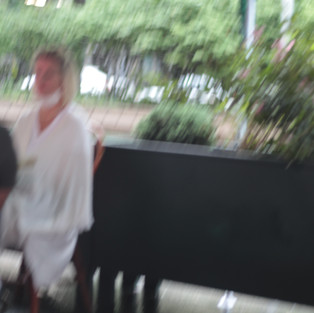3 Steps to Instantly Improve Your Street Photography
- Felix Steele Photography
- Oct 14, 2020
- 3 min read
When you're a street photography beginner, it's simple to get drawn into the trap of fast, mindless imaging. Many of us will frantically scramble to get as many shots as possible, without thinking about composition or lighting. However, a more considered approach to street photography will often yield better results, and there are a few key steps that the street shooter can take to overcome many of the challenges of urban photography.
1: Don't conceal your camera
Above: Images shot concealed with average settings. Note the blur and awkward composition.
A common mistake amongst beginners in the field of street photography is the myth that all street photographers shoot concealed, 'from the hip'. But there's no need to be secretive about the fact that you're taking photos, and there's no need to change your perspective in the name of disguise. One of the largest issues with this technique is sharpness. The constant movement of your leg as you walk the streets can fool even the most advanced image stabilization systems, and focusing is hard, especially for the slower contrast-detect systems found on many DSLRs (and some mirrorless cameras). This issue is only compounded by that of composition - almost impossible is you can't see the image you're about to shoot. Though there are cameras available on the market today that offer vertical viewfinders, their price eliminates them from general use, and although articulating screens could offer a similar perspective, they consume battery power fast, and their relative bulk makes them a less attractive proposition than simply conquering your fears and holding your viewfinder to your eye.

Above: an image where I paused to focus and perfect the composition.
2: Wait and shoot
Street photography, although it's far less considered than, say, landscape photography, is not as spontaneous as we'd like to think. A street image still requires care when it comes to focus and lighting, so devoting just a few seconds to the shot's AF and metering can mean a huge difference in the number of 'keepers' that you'll select for printing, editing, or sale. Select just one focus point, because it will make the job of your AF system much simpler, and place it over the subject's head or eye. Make sure you have a steady stance, and just take 5 seconds to check your settings and make sure your image's composition works. Check the edges of the frame for distracting objects, try stepping forward and backwards for different views, and you'll end up with a superior image.

A creative HDR look with light stars and intense shadows.
3: Be creative
Developing an original style is key if you want to produce effective street images. Look back through your files and find all the street images that you like. What do they have in common? Are they black & white? In portrait orientation? Try and develop a list of 10 consistent trends in your images, and consider them when you're next composing a shot. They're your go-to techniques, but it's crucial that you build on them. I've added vignettes with cloth lens socks, placed lights in front of the camera lens... whatever you come up with, try it out. You can create some truly striking looks by simply using flash, or a longer exposure than usual. The most important thing is that you keep experimenting when shooting. It's all too easy to reuse past compositions and techniques, letting your creative progress grow stagnant.
In short, once you start creating and developing your own style, the street photography possibilities are endless, but it's important to keep finding new ways to make your images your own.









Comments